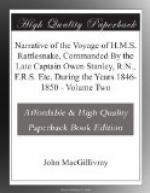The town of Horta contains, I was told, upwards of 10,000 inhabitants. It is prettily situated on the shores of a small bay, extending between two rocky headlands. The landing-place is at the remains of a mole under the walls of Fort Santa Cruz, the only one of numerous ruinous fortifications where a few guns are mounted; even these are in so wretched a condition that the commandant admitted that it would require several hours’ preparation before they would be fit to return our expected salute, and seemed glad when told that as a surveying ship we were exempted from saluting the flags of other nations. A sea wall runs along the face of the town; parallel with this is the principal street, with others at rightangles extending up the hill, the narrow streets are clean and well paved—the houses, generally of one storey, are built of tough grey trachyte.
Almost every inch of available ground upon the island of Fayal has been turned to good account: Indian corn is the chief agricultural product. With our usual bad fortune in this respect we were too late for the grapes and the oranges had not yet come in. The lower grounds are divided into small enclosures by stone walls, and subdivided by rows of a tall stout reed (Arundo donax) resembling sugarcane. Although taxes and other burdens are heavy, and wages very low, yet to a mere visitor like myself there appeared none of those occasional signs of destitution which strike one in walking through a town at home, nor did I see a single beggar.
In Fayal and Pico the most careless observer from the anchorage of Horta can scarcely fail to associate the number of smooth conical hills with former volcanic activity; and in looking over Captain Vidal’s beautiful charts of the Azores, nearly all the principal hills throughout the group are seen to have their craters or caldeiras. Fayal exhibits a fine specimen of one of these caldeiras in the central and highest part of the island. At an elevation of a little more than 3000 feet, we reached the ridge forming the margin of a circular crater, rather more than a mile in diameter, and 700 feet deep. The outer slope is gradual, but the inner walls are steep, deeply furrowed by small ravines and watercourses, and covered with grass, fern and heath-like bushes. The bottom contains a considerable extent of swampy meadowland, a shallow lagoon, and a small hill with a crater also partially filled with water. The view here is magnificent, enhanced, too, at times by the rolling volumes of mist overhead, at one moment admitting of a peep at the blue sky above, in the next concealing the rim of the crater and increasing in idea the height of its wall-like sides. The caldeira, I may add in conclusion, is said to have been formed during the last eruption of Fayal in 1672, but this statement appears to be very doubtful.
We resumed our homeward voyage on October 5th, and on November 9th, the Rattlesnake was paid off at Chatham, after having been in commission upwards of four years.




